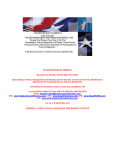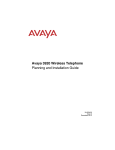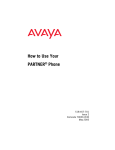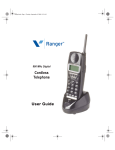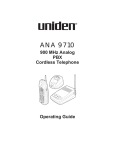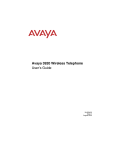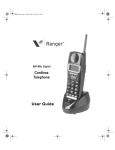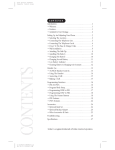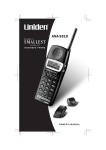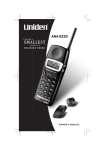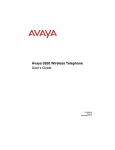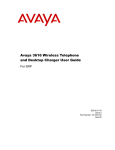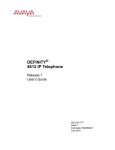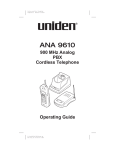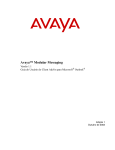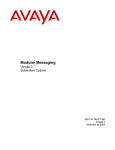Download Avaya 3810 Wireless Telephone Installation and Use
Transcript
Avaya 3810 Wireless Telephone Installation and Use 16-300055 Comcode 700313992 Issue 1 May 2004 Copyright 2004 Avaya Inc. All Rights Reserved Document 16-300055 Comcode 700313992 Issue 1 May 2004 Notice Every effort was made to ensure that the information in this book was complete and accurate at the time of printing. However, information is subject to change. Federal Communications Commission Statement This equipment has been tested and found to comply with Part 15 of the FCC Rules. These limits are designed to provide reasonable protection against harmful interference when the equipment is operated in a commercial environment. This equipment generates, uses, and can radiate radio-frequency energy and, if not installed and used in accordance with the instructions, may cause harmful interference to radio communications. Operation of this equipment in a residential area is likely to cause harmful interference, in which case the user will be required to correct the interference at his own expense. This system is Class B compliant in some configurations. Canadian Department of Communication (DOC) Interference Information This digital apparatus does not exceed the Class A limits for radio noise emissions set out in the radio interference regulations of Industry Canada. Le Présent Appareil Nomérique n’émet pas de bruits radioélectriques dépassant les limites applicables aux appareils numériques de la class A préscrites dans le reglement sur le brouillage radioélectrique édicté par le Industrie Canada. Preventing Toll Fraud “Toll fraud” is the unauthorized use of your telecommunications system by an unauthorized party (for example, a person who is not a corporate employee, agent, subcontractor, or working on your company’s behalf). Be aware that there may be a risk of toll fraud associated with your system and that, if toll fraud occurs, it can result in substantial additional charges for your telecommunications services. The final responsibility for securing both this system and its networked equipment rests with you – an Avaya Inc. system administrator, your telecommunications peers, and your managers. Avaya Inc. does not warrant that this product or any of its networked equipment is either immune from or will prevent either unauthorized or malicious intrusions. Avaya Inc. will not be responsible for any charges, losses, or damages that result from such intrusions. Avaya Fraud Intervention If you suspect you are being victimized by toll fraud and you need technical support assistance, call the Avaya Customer Care Center at 1 800 628-2888. Warranty Avaya Inc. provides a limited warranty on this product. Refer to the “Limited Use Software License Agreement” card provided with your package. Trademarks MERLIN MAGIX and IP Office are registered trademarks of Avaya Inc. in the U.S. and other countries. Ordering Information Call: Avaya Publications Center Voice 1 800 457-1235 International Voice 207 866-6701 Fax 1 800 457-1764 International Fax 207 866-6099 Email: [email protected] Write: GlobalWare Solutions 200 Ward Hill Avenue Haverhill, MA 01835 USA Attn: Avaya Account Manager Order: Avaya Publications Center Document No. 16-300055 Comcode: 700313992 Issue 1, May 2004 Customer Support If you need assistance when programming or using your system, contact your local Authorized Dealer or call the Avaya Customer Care Center at 1 800 628-2888. Consultation charges may apply. Avaya Web Page For information about Avaya products and service, go to www.avaya.com. For the most current version of this document, go to www.avaya.com/support. 0 Important Safety Instructions The following list provides basic safety precautions that should always be followed when using your telephone equipment. 1. Read and understand all instructions. 2. Follow all warnings and instructions marked on the product. 3. Unplug all telephone connections before cleaning. DO NOT use liquid cleaners or aerosol cleaners. Use a damp cloth for cleaning. 4. This product should be serviced by (or taken to) a qualified repair center when service or repair work is required. 5. DO NOT use this product near water, for example, in a wet basement location. 6. DO NOT place this product on an unstable cart, stand or table. 7. Never push objects of any kind into slots or openings as they may touch dangerous voltage points or short out parts that could result in a risk of fire or electric shock. Never spill liquid of any kind on the product. 8. DO NOT use the telephone to report a gas leak in the vicinity of the leak. Contents 1 Introduction 7 Welcome ........................................................................................................ 7 Organization................................................................................................... 7 Conventions ................................................................................................... 8 Related Documents........................................................................................ 8 2 Installing the Telephone 9 Overview ........................................................................................................ 9 Select Base Unit Location ............................................................................ 11 Install the Base Unit on a Desktop ............................................................... 12 Install the Base Unit on a Standard Wall Plate ............................................ 14 Install the Base Unit Directly on a Wall ........................................................ 17 Apply Power to the Charger Unit.................................................................. 21 Mount the Charger Unit on a Wall (Optional) ............................................... 22 Install the Handset Battery ........................................................................... 23 Charge the Battery for the First Time........................................................... 24 Charge the Spare Battery ............................................................................ 25 Install a Headset (Optional).......................................................................... 26 Attach the Belt Clip to the Handset .............................................................. 27 Remove the Belt Clip from the Handset .................................................... 28 3 About Your Telephone 29 Overview ...................................................................................................... 29 Handset........................................................................................................ 30 Base Unit...................................................................................................... 33 Charger Unit................................................................................................. 34 Clean the Charger Unit Contacts............................................................... 35 Battery.......................................................................................................... 36 Low Battery Indications ............................................................................. 36 Table of Contents 5 Table of Contents 4 Using Your Telephone Installation and Use 37 Overview ...................................................................................................... 37 Handset Modes ............................................................................................ 37 Handling Calls .............................................................................................. 38 Make a Call................................................................................................ 38 Answer a Call............................................................................................. 38 Place a Call on Hold .................................................................................. 39 Transfer a Call ........................................................................................... 39 Conference a Call ...................................................................................... 39 Redial Last Number ................................................................................... 40 Mute a Conversation.................................................................................. 40 Select a Channel ....................................................................................... 40 Changing Handset Settings.......................................................................... 41 Change Earpiece Volume.......................................................................... 41 Change Ring Type and Volume................................................................. 41 Set Vibrate Mode ....................................................................................... 42 Turn Ringer Off .......................................................................................... 42 A Troubleshooting 43 B Specifications 47 C Accessories 49 D Installation Guidelines 51 Overview ...................................................................................................... 51 Determining the Location for the Base Units................................................ 53 6 Table of Contents 1 Introduction Welcome This guide provides instructions on how to install and use your Avaya 3810 Wireless Telephone. This chapter explains how this guide is organized, shows the typographical conventions used, and provides the Avaya Support Center web site to access for additional documentation. Organization This guide is organized as follows: • Chapter 1, “Introduction” provides a brief description of the contents of each chapter, the typographical conventions used, and the Avaya Support Center web site. • Chapter 2, “Installing the Telephone” provides installation instructions. • Chapter 3, “About Your Telephone” describes the handset, including operating controls and buttons; batteries; and base and charger units. • Chapter 4, “Using Your Telephone” describes basic call handling operations and how to change handset settings. • Appendix A, “Troubleshooting” describes performance problems and suggestions to correct the problems. • Appendix B, “Specifications” provides telephone specifications. • Appendix C, “Accessories” lists the accessories available for the telephone. • Appendix D, “Installation Guidelines” provides the general guidelines for installing Avaya 3810 Wireless Telephones. Welcome 7 1 Introduction Installation and Use Conventions • Numbers, the asterisk, and the pound sign on the dialpad are shown in a button, for example: 2, *, or #. • Bold type is used to indicate buttons on the Handset, other than those on the dialpad. • Courier type indicates text that appears in the handset display. Related Documents For additional documentation and the most current version of this document, go to the Avaya Support Center at www.avaya.com/support. 8 Conventions 2 Installing the Telephone Overview This chapter explains how to install the Avaya 3810 Wireless Telephone. The sections provided in this chapter are as follows: 1 “Select Base Unit Location” on page 11. 2 “Install the Base Unit on a Desktop” on page 12. 3 “Install the Base Unit on a Standard Wall Plate” on page 14. 4 “Install the Base Unit Directly on a Wall” on page 17. 5 “Apply Power to the Charger Unit” on page 21. 6 “Mount the Charger Unit on a Wall (Optional)” on page 22. 7 “Install the Handset Battery” on page 23. 8 “Charge the Battery for the First Time” on page 24. 9 “Charge the Spare Battery” on page 25. 10 “Install a Headset (Optional)” on page 26. 11 “Attach the Belt Clip to the Handset” on page 27. The Avaya 3810 Wireless Telephone can be used with the Avaya IP Office System Release 2.0 or later and the MERLIN MAGIX® Integrated System. Overview 9 2 Installing the Telephone Installation and Use The Avaya 3810 Wireless Telephone is packaged with this installation and use guide and the components shown below. If any of these items are missing or damaged, contact your System Administrator. Figure 1: Avaya 3810 Wireless Telephone Components Pow er/S tatu s 38 10 Base Unit 2 AC Adapters Charger Unit 10 Overview Telephone Cord Handset Rechargeable Battery Beltclip Wall Mount Stand Installation and Use 2 Installing the Telephone Select Base Unit Location • Select a location that is not subject to excessive heat or humidity. • Determine if the base unit will sit on your desk or be wall mounted. • Place the base unit near a standard 120VAC outlet and within reach of a telephone jack that is connected to the communications system. Avoid a location that is surrounded by metal surfaces. ! ! WARNING: If the base unit is installed in a separate building from the communications system, you must install In-Range Out of Building (IROB) protectors. The IROB used with the Avaya 3810 Wireless Telephone is Module 146E (IROB Two) Dual IROB. To order an IROB, contact your local Authorized Dealer. • Place the base unit away from any electrical component, such as PCs, monitors, and other telephones. • If more than one base unit is being installed, each base unit must be placed at least 5 feet apart. • Keep the base unit and handset away from sources of electrical noise, such as motors and fluorescent lighting. Select Base Unit Location 11 2 Installing the Telephone Installation and Use Install the Base Unit on a Desktop This section provides procedures to install the base unit on a desktop or table. If you want to mount the base unit on a wall, go to “Install the Base Unit on a Standard Wall Plate” on page 14 or “Install the Base Unit Directly on a Wall” on page 17. 1 Plug one end of the 14-foot telephone cord into the “Line In” jack on the base unit. 2 Plug the other end of the telephone cord into the telephone jack that is connected to your communications system. Figure 2: Connect Telephone Cord Telephone jack connected to communications system Line In jack 12 Install the Base Unit on a Desktop Installation and Use 2 Installing the Telephone 3 Plug the AC adapter cord into the AC adapter input jack on the base unit. 4 Plug the AC adapter into a standard 120VAC wall outlet. Figure 3: Connections to Base Unit Telephone jack connected to communications system 3 AC Adapter 4 Line In jack 1 2 5 Check to see that the power LED is on. 6 Raise the base unit antenna to the vertical position. The antenna should be perpendicular to the base unit. Figure 4: Raise Base Unit Antenna Po we r/ Sta tus 38 10 Install the Base Unit on a Desktop 13 2 Installing the Telephone Installation and Use Install the Base Unit on a Standard Wall Plate This section provides procedures to mount the base unit on the wall if a standard wall plate, with a telephone jack connected to the communications system, is installed in the wall. If you want to mount the base unit on the wall and a standard wall plate is not installed, go to “Install the Base Unit Directly on a Wall” on page 17. ! CAUTION: Do not mount the base unit on the ceiling. 1 To attach the wall mount stand to the base unit, slide the wall mount stand into the notches at the top of the base unit. Then pull the wall mount stand down and snap it into place. Figure 5: Attach Wall Mount Stand to Base Unit 14 Install the Base Unit on a Standard Wall Plate Installation and Use 2 Installing the Telephone 2 Plug one end of the 14-foot telephone cord into the “Line In” jack on the base unit. 3 Plug the AC adapter cord into the AC adapter input jack on the base unit. Figure 6: Plug Cords into Base Unit Line In jack 4 Place the AC adapter cord and the telephone cord inside the molded channels of the wall mount stand. 5 Plug the other end of the telephone cord into the telephone jack in the wall plate. Figure 7: Place Cords in Molded Channels Install the Base Unit on a Standard Wall Plate 15 2 Installing the Telephone Installation and Use 6 Place the base unit on the posts of the wall plate and pull down until the base unit is firmly seated. Figure 8: Mount Base Unit on Wall Plate 7 Plug the AC adapter into a standard 120VAC wall outlet. Figure 9: Plug AC Adapter into Wall Outlet AC Adapter 8 Check to see that the power LED is on. 9 Raise the base unit antenna to the vertical position. The antenna should be parallel to the wall. 16 Install the Base Unit on a Standard Wall Plate Installation and Use 2 Installing the Telephone Install the Base Unit Directly on a Wall This section provides procedures to mount the base unit directly on a wall if a standard wall plate is not installed. Use #10 screws and, if necessary, anchoring devices that are suitable for the wall material where the base unit will be placed. ! CAUTION: Do not mount the base unit on the ceiling. 1 Insert two mounting screws into the wall 3 and 15/16 inches apart. Allow about 3/16 of an inch between the wall and screw heads for mounting the base unit. Figure 10: Insert Mounting Screws Install the Base Unit Directly on a Wall 17 2 Installing the Telephone Installation and Use 2 To attach the wall mount stand to the base unit, slide the wall mount stand into the notches at the top of the base unit. Then push the wall mount stand down and snap it into place. Figure 11: Attach Wall Mount Stand to Base Unit 3 Plug one end of the 14-foot telephone cord into the “Line In” jack on the base unit. 4 Plug the AC adapter cord into the AC adapter input jack on the base unit. Figure 12: Plug Cords into Base Unit Line In jack 18 Install the Base Unit Directly on a Wall Installation and Use 2 Installing the Telephone 5 Place the AC adapter cord and the telephone cord inside the molded channels of the wall mount stand. Figure 13: Place Cords in Molded Channels 6 Place the base unit on the posts of the wall screws and pull down until the base unit is firmly seated. Figure 14: Place Base Unit on Wall Screw Posts Install the Base Unit Directly on a Wall 19 2 Installing the Telephone Installation and Use 7 Plug the other end of the telephone cord into the telephone jack connected to the communications system. Figure 15: Plug Telephone Cord into Telephone Jack 8 Plug the AC adapter into a standard 120VAC wall outlet. Figure 16: Plug AC Adapter into Wall Outlet AC Adapter 9 Check to see that the power LED is on. 10 Raise the base unit antenna to the vertical position. The antenna should be parallel to the wall. 20 Install the Base Unit Directly on a Wall Installation and Use 2 Installing the Telephone Apply Power to the Charger Unit 1 Plug the AC adapter cord into the input jack on the back of the charger unit. 2 Wrap the AC adapter cord around the strain relief. 3 Plug the AC adapter into a standard 120VAC wall outlet. Always route the power cord away from high-traffic areas, and where it cannot become chafed and create a fire or electrical hazard. Figure 17: Apply Power to Charger Unit Strain Relief 4 If you want to mount the charger unit on the wall, go to “Mount the Charger Unit on a Wall (Optional)” on page 22. Otherwise, go to “Install the Handset Battery” on page 23. Apply Power to the Charger Unit 21 2 Installing the Telephone Installation and Use Mount the Charger Unit on a Wall (Optional) The charger unit can be mounted directly on the wall. Use #10 screws and, if necessary, anchoring devices that are suitable for the wall material where the charger unit will be placed. 1 Insert two mounting screws into the wall 1 9/10 inches apart. Allow about 3/16 of an inch between the wall and screw heads for mounting the charger unit. Figure 18: Insert Mounting Screws into Wall 3/16" 1 9/10" 2 Place the charger unit on the posts of the wall screws and push down until it is firmly seated. Figure 19: Place Charger Unit on Wall Screw Posts Strain Relief 3/16" 22 1 9/10" Mount the Charger Unit on a Wall (Optional) Installation and Use 2 Installing the Telephone Install the Handset Battery 1 Remove the battery cover from the back of the handset by pressing the latch and sliding the cover down until it comes off the handset. Figure 20: Remove Battery Cover 2 Slide the battery down into the handset. Figure 21: Install Handset Battery 3 Close the battery compartment cover by sliding it up until it snaps into place. Figure 22: Close Battery Cover 4 If you are using the battery for the first time, go to “Charge the Battery for the First Time” on page 24. Install the Handset Battery 23 2 Installing the Telephone Installation and Use Charge the Battery for the First Time Before using your handset for the first time, the battery must be continuously charged for 16 to 20 hours. (After the battery is charged for the first time, it will only take five to six hours for the battery to be fully recharged.) 1 Install the battery in the handset. Go to “Install the Handset Battery” on page 23. 2 Place the handset in the charger unit. Figure 23: Place Handset in Charger Unit p 3 Ensure that the Charge LED lights. If it does not, make sure that the AC adapter is plugged in and that the Handset is making good contact with the charger unit. 24 Charge the Battery for the First Time Installation and Use 2 Installing the Telephone Charge the Spare Battery It is recommended that you have a spare battery always charging to protect against complete battery discharge. The charger unit is equipped to charge the spare battery with or without the handset in the front slot. See Appendix C, “Accessories” for information on ordering a spare battery. 1 Slide the spare battery into the rear slot in the charger unit until the retaining clip snaps over the top of the battery. Figure 24: Charge Spare Battery 2 Ensure that the Batt Charge indicator lights. If it does not, make sure that the AC adapter is plugged in and that the spare battery is making good contact with the Charger Unit. 3 Charge the spare battery for 16 to 20 hours. 4 When charging is complete, press out on the latch to remove the spare battery for use. If you don’t need the spare battery immediately, leave it in the charging compartment; it will not overcharge. See information about the low battery indicator in “Description of Icons in Handset Display” on page 32. 438 Charge the Spare Battery 25 2 Installing the Telephone Installation and Use Install a Headset (Optional) The optional headset provides a hands-free option when you use the belt clip to carry the handset and conduct a conversation. All feature operations remain the same except the handset earphone and microphone are disconnected. 1 Open the cover over the Headset jack that is located on the top of the Handset. 2 Plug in the headset. Only use headsets especially designed or modified for use with radio frequency equipment. Figure 25: Install Headset 26 Install a Headset (Optional) Installation and Use 2 Installing the Telephone Attach the Belt Clip to the Handset You can use the belt clip to attach the handset to your belt or pocket. 1 Slide the clip into the tab stop. The belt clip is designed to fit snugly onto the handset. Figure 26: Attach Belt Clip to Handset on of f 2 Press firmly until it snaps into place. Figure 27: Press Belt Clip onto Handset on f of Attach the Belt Clip to the Handset 27 2 Installing the Telephone Installation and Use Remove the Belt Clip from the Handset 1 Press the retain clip in toward the belt clip blade and slide the clip up at the same time. Figure 28: Remove Belt Clip from the Handset on of 28 Attach the Belt Clip to the Handset f 3 About Your Telephone Overview The Avaya 3810 Wireless Telephone is a digital telephone designed to work with your communications systems. It offers the mobility inherent in a wireless telephone plus access to the features and functionality of the communications system. The Avaya 3810 telephone uses long-range 900 MHz digital technology and provides the following features: • 2-line, 32 character Handset Liquid Crystal Display (LCD) • 4 displayed operation modes indicating Talk, Ringer On/Off, Battery Low, and Message Waiting • Single button access to fixed features — Hold, Transfer, Conference, and Redial • 4 programmable buttons to access features on the communications system • 10 channels, supporting up to 10 simultaneous conversations • Headset jack • Ringer and Handset volume control • Vibrate alert • base unit and charger unit This chapter describes the Avaya 3810 Wireless Telephone handset, base unit, charger unit, and battery. Overview 29 3 About Your Telephone Installation and Use Handset Figure 29: Avaya 3810 Wireless Telephone Handse t ON R/VOL MUTE OFF HOLD TALK TRNSFR CONF CHANNEL REDIAL 1 Ringer ON/OFF switch 10 Volume (R/VOL) Button 2 Handset Display 11 Mute (MUTE) Button 3 Hold (HOLD) Button 12 Transfer (TRNSFR) Button 4 Talk (TALK) Button 13 Conference (CONF) Button 5 Dialpad 14 Redial (REDIAL) Button 6 Programmable Button 15 Channel (CHANNEL) Button 7 Programmable Button 16 Programmable Button 8 Microphone 17 Programmable Button 9 Head Set Jack 30 Handset Installation and Use 3 About Your Telephone Description of Handset Buttons Button Description Ringer On/Off Switch (on side) Turns handset ringer on or off. The handset does not ring or vibrate. HOLD Places a call on hold until you can return to it. TALK Initiates, answers, and disconnects calls. Dialpad 12-button dialpad for placing calls or accessing features. Programmable buttons Features programmed on the four programmable buttons are determined by communications system programming. See your System Administrator for information about the features programmed on your buttons. R/VOL (on side) Changes earpiece volume when pressed during a call. Changes ringer tones and volume when pressed when the handset is out of the charger unit and not active on a call. MUTE (on side) Mutes your conversation so that the other party cannot hear your voice but you can hear theirs. TRNSFR Transfers a call to another extension. CONF Connects another call to a call already in progress for a three-way conversation. REDIAL Redials the last number. CHANNEL Selects a different channel. Handset 31 3 About Your Telephone Installation and Use Handset Display The handset display has two 16-character lines and one line of icons that provide calling information and operating conditions. Figure 30: Handset Display A descriptions of the icons that appear in the handset display are provided in the following table. Description of Icons in Handset Display Icon Description TALK The Talk icon indicates a connection between the handset and base unit. OFF The Ringer Off icon indicates the handset ringer switch is off. LOW The Battery Low icon indicates the battery in the Handset is low and needs to be charged. Return the handset to the charger unit or replace the handset battery with another charged battery. The Message Waiting icon indicates you have a message. See your System Administrator for instructions on how to retrieve your messages. 32 Handset Installation and Use 3 About Your Telephone Base Unit The base unit can be mounted on a wall or placed on a desk. There is one red power LED that indicates the base unit has power. Figure 31: Base Unit Po we r/S tatu s 38 10 Base Unit 33 3 About Your Telephone Installation and Use Charger Unit The handset comes with a charger unit that functions as a cradle for the handset when in Standby Mode (or idle) and a charger for the handset battery. The charger unit also has a rear slot for spare battery charging. Two LEDs indicate the handset battery and spare battery are charging and making good contact with the charger unit. Figure 32: Charger Unit 34 Charger Unit Installation and Use 3 About Your Telephone Clean the Charger Unit Contacts It is important to clean all charging contacts on the charger unit and on the handset and spare battery about once a month. Use a pencil eraser or a soft dry cloth. Do not use any liquids or solvents. Figure 33: Clean Charger Unit Contacts Charger Unit 35 3 About Your Telephone Installation and Use Battery Your wireless telephone comes with one nickel-metal hydride rechargeable battery that provides up to 10 hours of talk time (fully charged). Low Battery Indications If the battery runs low while a call is in progress, the Battery Low icon appears in the handset display, and the handset beeps once every three seconds. If the battery is low while the telephone is in Standby Mode: • Battery Low icon appears in the handset display • Handset beeps every 15 seconds for 3 minutes • None of the buttons operate • Handset cannot make or receive calls It is recommended that you have a spare battery always charging to ensure against complete battery discharge. See “Charge the Spare Battery” on page 25 for more information. To restore the battery capacity, return the handset to the charger unit for charging or replace the handset battery with a charged one. The battery can remain in the charger unit for over one month. 36 Battery 4 Using Your Telephone Overview This chapter describes the three handset modes and provides procedures on how to handle calls and change handset settings. Handset Modes There are three modes in which the handset operates: • AutoAnswer Mode. When the handset is in the charger unit, it is in AutoAnswer mode. You are automatically connected to an incoming call when you remove the handset from the charger unit and automatically disconnected from the call when you place the handset back in the charger unit. • Standby Mode. When the handset is out of the charger unit and not in use, it is in Standby mode. You must press TALK to answer an incoming call and to hang up. • Talk Mode. When the handset is out of the charger unit and in use, it is in Talk mode. The Talk icon appears in the handset display. Overview 37 4 Using Your Telephone Installation and Use Handling Calls This section describes how to: • Make and answer calls • Place a call on hold • Transfer a call • Conference a call • Redial the last number • Mute a conversation • Select a channel The Avaya 3810 Wireless Telephone does not have a f. You cannot program a f to your Avaya 3810 Wireless Telephone. To use account codes on a MERLIN MAGIX system, you must go off-hook on a SA button, press #, and then enter the account code. Make a Call 1 Press TALK. 2 When you hear dial tone, enter the extension or telephone number using the dialpad. 3 When you are finished with the call, press TALK to hang up. Answer a Call 1 Do one of the following: • If the handset is out of the charger unit, press TALK to answer the call. • If the handset is in the charger unit, pick up the handset to answer the call. You are automatically connected to the call. 2 When you are finished with the call, press TALK to hang up. 38 Handling Calls Installation and Use 4 Using Your Telephone Place a Call on Hold 1 While on a call, press HOLD. 2 To resume a call, you must be in Talk mode. Depending on your communications system, you either press HOLD or press the button representing the call on hold. Transfer a Call 1 While on a call, press TRNSFR. 2 When you hear dial tone, dial the extension or telephone number to which the call is being transferred. 3 Do one of the following: • To transfer the call without announcing it, press TRNSFR again. • To announce the call before transferring, wait for the called party to answer. When the called party answers, announce the call and press TRNSFR again. 4 Press TALK to hang up. Conference a Call 1 While on a call, press CONF. Depending on your communications system, you will hear dial tone or you must select a line. 2 Dial the extension or telephone number. 3 When the other party answers, press CONF to have a three-way conversation. Handling Calls 39 4 Using Your Telephone Installation and Use Redial Last Number Perform one of the following steps: • Press TALK, and then press REDIAL. • Press REDIAL. The handset will go off-hook automatically and dial the number. Mute a Conversation 1 While on a call, press MUTE. The handset speaker is muted so you can consult another person in the room without the caller hearing you. 2 Press MUTE again to turn the handset speaker back on. Select a Channel When you make or receive a call, an available channel is automatically selected. However, if you have a connection that is not clear, press CHANNEL to select a channel that provides the clearest communication. If you want to use more than one wireless telephone in your office, they must operate on different channels. 40 Handling Calls Installation and Use 4 Using Your Telephone Changing Handset Settings This section describes how to: • Change the earpiece volume • Change the ring type and volume • Set Vibrate mode • Turn the ringer off Change Earpiece Volume Press R/VOL on the side of the handset during a call to change the earpiece volume on the handset. Change Ring Type and Volume Press R/VOL on the side of the handset in Standby mode (the handset is out of the charger unit and not in use) to change the ring type and volume. Repeatedly press R/VOL until you hear the ring type and volume you want. The handset has three types of rings and each ring type has a high and low volume. As you press R/VOL, the ring type and volume selections are audible and visible in the handset display. The ring type and volume combinations are as follows: • Ring Type A (High) • Ring Type A (Low) • Ring Type B (High) • Ring Type B (Low) • Ring Type C (High) • Ring Type C (Low) • Ring Off Changing Handset Settings 41 4 Using Your Telephone Installation and Use Set Vibrate Mode 1 Turn the Ringer Switch on the side of the handset to ON. 2 Repeatedly press R/VOL on the side of the handset until you feel the handset vibrate. Ring Off will also appear in the handset display. If the handset is set to vibrate and the handset is in the charger unit when there is an incoming call, you will hear a low ring. Turn Ringer Off Turn the Ringer Switch on the side of the handset to OFF. 42 Changing Handset Settings A Troubleshooting If your Avaya 3810 Wireless Telephone is not performing to your expectations, try the suggestions provided in the following table. If you are still unable to resolve the problem, contact your telephone System Administrator. Do not attempt to service this unit yourself. All service must be done by qualified service personnel. Condition Suggestion Charge LED does not light when handset is placed in charger unit. Make sure the AC adapter is plugged into the charger unit and wall outlet. If the AC adapter is plugged into a wall outlet with a switch, make sure the switch is turned on. Make sure the handset is properly seated in the charger unit. Make sure the battery is properly seated in the handset. Make sure that the charging contacts on the handset and charger unit are clean. Use a soft dry cloth to clean contacts. Do not use any liquids or solvents. Conversation is interrupted frequently. Make sure that the base unit antenna is fully vertical. Move closer to the base unit. 43 A Troubleshooting NO SERVICE appears in the handset display. Installation and Use You may be at the range limit; move closer to the base unit. Make sure there is power going to the base unit. Check the connection between the communications system and the base unit. Determine the number associated with the telephone. Dial that telephone number from a “wired” telephone. If you hear busy tone, the base unit is not communicating with the communications system. Perform the following steps: • Check the power. • Verify that the telephone cord is connected to the base unit. • Verify that the ID of the handset matches the ID of the base unit. To determine the ID of the handset, remove the battery cover and look at the ID on the bottom of the handset. (A bar code appears below the ID.) To determine the ID of the base unit, look at the ID on the bottom of the base unit. • Verify that the installation guidelines have been followed, especially for systems where there are more than three Avaya 3810 Wireless Telephones. Echo during conversation 44 Depending on the environment from which you are calling, such as a noisy area, a caller may experience echo if the volume control of the handset is set too high. Try lowering the volume on your handset. If that does not help, contact your authorized dealer. Installation and Use A Troubleshooting No dial tone. Move closer to the base unit. Handset does not ring. The battery could be weak. Charge the battery for 16 to 20 hours. Check the Ringer Switch; it could be turned off. Make sure the base unit antenna is fully vertical. Move closer to the base unit. An underscore replaces a character in the handset display. The telephone does not recognize special characters (for example, punctuation marks) that are provided from the communications system. 45 A Troubleshooting 46 Installation and Use B Specifications General Frequency Control Phase Lock Loop Modulation Spread Spectrum Operating Temperature 0° to 50° C (+32° F to +122° F) Base Unit Receive/Transmit Frequency 902 MHz to 928 MHz Peak RF Output/Transmit Power Approximately 60 mW Power Requirements 10V DC from supplied AC adapter Size Width – 4 1/4 inches Depth – 7 1/2 inches Height – 2 1/4 inches Weight Approximately 15.4 oz. Handset Receive/Transmit Frequency 902 MHz to 928 MHz Power Requirements Nickel Metal-Hydride rechargeable battery Size Width – 2 1/5 inches Depth – 1 2/3 inches Height – 8 2/3 inches with antenna Weight Approximately 8.8 oz. with battery Battery Capacity – 1300 mAh, 3.6 V Talk Time – 10 hours (typical) Standby Time – 6 days (typical) 47 B Specifications 48 Installation and Use C Accessories A list of accessories for the Avaya 3810 Wireless Telephone is provided in the following table. To order an accessory, contact your local Authorized Dealer. Accessory Description AD970 AC Adapter for Charger BT2499A Battery (1300 mAh) EXP9660 Wall Mount Plate EXP9702 Belt Clip EXP9704 AC Adapter for Base Unit EXP9783 Leather Carrying Case EXP9785AV Charger (without AC Adapter) Trans Radium Mobility Headset (requires adapter cord, MC#408121085) Trans Supra Mobility Headset (requires adapter cord, MC#408121085) Adapter Cord 3275-DWS 49 C Accessories 50 Installation and Use D Installation Guidelines Overview This section provides general guidelines for installing the Avaya 3810 Wireless Telephones. Following these guidelines will help ensure satisfactory performance of the Avaya 3810 Wireless Telephones. Before installing the Avaya 3810 Wireless Telephones, keep in mind the following information: • If possible, place the base unit in a centralized location relative to the locations where the Avaya 3810 Wireless Telephone will be used. • Install the base unit as high as possible so that it clears nearby objects (for example, office cubicles and file cabinets). • More than three base units in a confined area will degrade product performance. Refer to “Determining the Location for the Base Units” on page 53 to optimize locations of up to 10 base units in a building or desired coverage area. • Each Avaya 3810 Wireless Telephone requires its own base unit. If you have three or fewer Avaya 3810 Wireless Telephones, place the base units in a centralized location. (See Figure 34.) Overview 51 D Installation Guidelines Installation and Use Figure 34: Configuration with Three Avaya 3810 Wireless Telephones 3810 3810 3810 Location of Base Units If you have more than three Avaya 3810 Wireless Telephones, go to “Determining the Location for the Base Units” on page 53. 52 Overview Installation and Use D Installation Guidelines Determining the Location for the Base Units To obtain the best possible performance from the Avaya 3810 Wireless Telephones, you must install the base units in a location that will provide proper coverage. To determine the location for the base units, perform the following steps: 1 Draw a floor plan of your building. Figure 35 shows the floor plan for a sample company. Figure 35: Floor Plan for a Sample Company 2 Identify all of the people in your company who will use an Avaya 3810 Wireless Telephone. Determining the Location for the Base Units 53 D Installation Guidelines Installation and Use 3 On your floor plan, identify all areas (for example, offices, conference rooms, and lobbies) where you expect the Avaya 3810 Wireless Telephones to be used. (See Figure 36.) 4 On your floor plan, identify the location where you want to install the base units for the Avaya 3810 Wireless Telephones (for example, a hallway). Figure 36 shows the completed floor plan and base unit location for the sample company. Figure 36: Location of Base Units for a Sample Company 3810 3810 3810 3810 3810 3810 3810 Location of Base Units 54 Determining the Location for the Base Units 3810 Installation and Use D Installation Guidelines 5 Using the base unit location as the center, draw a circle with a 160 foot radius. This circle indicates the coverage area of the base units. Figure 37 shows the coverage area for the sample company. Figure 37: Coverage Area of the Base Units 3810 Pr ed ict ed 3810 Se rv ice Ar ea 3810 3810 3810 3810 3810 3810 Location of Base Units 6 Verify whether the circle encompasses all of the areas where the Avaya 3810 Wireless Telephones will be used. Determining the Location for the Base Units 55 D Installation Guidelines Installation and Use 7 Perform one of the following steps: — If the circle encompasses all of the areas where the Avaya 3810 Wireless Telephones will be used, go to Step 9. — If the circle does not encompass all of the areas where the Avaya 3810 Wireless Telephones will be used, perform one of the following steps: • Select a location for the base units that is “centrally located” within the area where the Avaya 3810 Wireless Telephones will be used. (This new location should encompass all of the areas where the Avaya 3810 Wireless Telephones will be used.) • Identify a base unit location for the Avaya 3810 Wireless Telephones that are not covered by the current base unit location. Draw a circle with a 160 radius around this second base unit location, and verify that the circle encompasses those Avaya 3810 Wireless Telephones that were not covered by the first base unit location. Figure 37 shows multiple locations of base units for a sample company. Figure 38: Multiple Locations for Base Units 3810 3810 3810 3810 3810 3810 3810 3810 Location of Base Units 56 Determining the Location for the Base Units Installation and Use D Installation Guidelines 8 Repeat Step 7 until all of the Avaya 3810 Wireless Telephones are included in an area covered by the base units. 9 After all of the Avaya 3810 Wireless Telephones are covered on your floor plan, perform one of the following steps: — If you have one to three base units, install each base unit at least five feet apart in the selected location. Be sure to install each base unit as high as possible so it clears nearby objects (for example, office cubicles and file cabinets). This grouping of base units is referred to as a cluster. — If you have four or more base units: a Install three of the base units in the selected location, with each base unit being five feet away from another base unit. Be sure to install each base unit as high as possible so it clears nearby objects (for example, office cubicles and file cabinets). This grouping of base units is referred to as a cluster. b Select a location that is at least 30 feet away from the cluster, and install another cluster of up to three base units. Within this new cluster, make sure each base unit is five feet away from another base unit. Be sure to install each base unit as high as possible so it clears nearby objects (for example, office cubicles and file cabinets). c Repeat Step b until all of the base units are installed. When you are finished determining the location for the base units, install the base units and perform a test call from each handset. Be sure to walk to all areas where the handset will be used so you can determine whether the voice quality is acceptable. Determining the Location for the Base Units 57 D Installation Guidelines 58 Determining the Location for the Base Units Installation and Use


























































